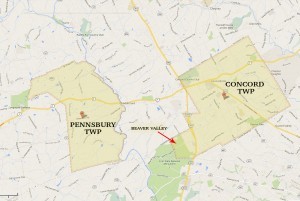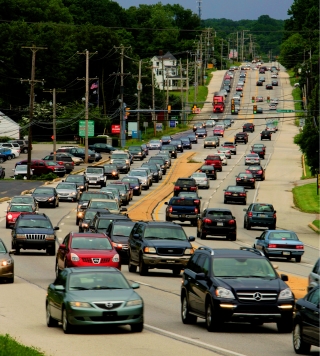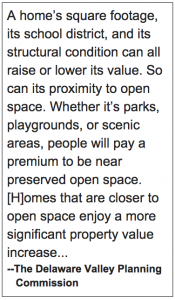A Tale of Two Townships
Pennsbury Supervisors Will Purchase Developer-Owned Open Space…
October 29, 2014
The supervisors of Pennsbury Township, Chester County — just a couple of miles from Beaver Valley — just made an incredible announcement. They will be purchasing, from a Toll Brothers subsidiary, 23 acres of land adjacent to a township park on Route 1 for the sum of $4 million which they will borrow at 2.6% over 20 years. With only a tiny fraction of the tax base of Concord Township, the Pennsbury Supervisors have shown courage and foresight to propose protecting an important piece of open space which was slated for a dense townhouse development. A comparison of Concord and Pennsbury Townships is in order to show why this is such a big deal and why Concord residents will agree that protecting their township’s remaining open space goes beyond the usual ecological, historical, and recreational arguments. Saving Concord’s remaining open space offers clear economic benefits and tax savings.

Concord and Pennsbury are about the same size but are dramatically different townships.
Despite the fact that Route 1 passes through the heart of both similarly-sized townships, Pennsbury and Concord are drastically different places. Concord is 13.7 square miles in size and Pennsbury 10.4 sq. miles, yet Concord has about 19,000 residents to Pennsbury’s 3,700. Concord surpasses the density requirements to be classified as a third-class city while Pennsbury is a semi-rural bedroom community. Pennsbury has virtually none of the commercial development that Concord has: no Costco, Wegmans, Home Depot, Target, Acme, or Whole Foods. It doesn’t have three Wawas, three car dealerships, five hotels, a dozen banks, nearly twenty restaurants, two large industrial parks, or three large shopping centers. Pennsbury’s stretch of Route 1 looks as Concord’s once did before it was jammed with extensive commercial development and corporate centers up and down Routes 1 and 202. It has a couple of restaurants, a small antique mall, a winery, and a few other small businesses. It doesn’t have Concord’s nearly two thousand expensive new homes. Concord Township has a HUGE commercial and residential tax base compared to Pennsbury’s. Amazingly, despite the size of this tax base, the total taxes that Concord residents are billed significantly exceed what Pennsbury residents pay. How can this be? The American Farmland Trust conducted a well-regarded study which explains this paradox.
According to the AFT:
“Many jurisdictions believe they will make money on the property taxes from new subdivisions, ignoring the true cost of schools, roads, police, water, and stormwater management. Studies show that it costs between $1.04 and $2 for every dollar of tax revenue to provide services to a typical subdivision, so current taxpayers end up subsidizing outsiders who bring increased traffic, crowded schools, and the loss of the community’s individual culture. It is also cheaper to protect clean water at its source than to build expensive water treatment facilities.”

A not-so-hidden cost of development.
When comparing what Concord and Pennsbury residents pay in taxes, it’s important to consider the entire tax bill. For example, Pennsbury’s township tax comes in at 1.49 mills versus Concord’s .94 mills. However, the Pennsbury school tax millage rate is 26.4 (Unionville–Chadds Ford) and Concord’s is 29.4 (Garnet Valley). So, for a house assessed at $400,000, the township taxman would take $596 in Pennsbury and $376 in Concord. The school tax collector, on the other hand, gets $11,760 for GVSD whereas Pennsbury residents pay $10,560 to UCFSD. Concord’s slightly lower township tax is more than offset by a higher school tax millage rate. (Of course, the tax paid depends on a home’s assessed value which is usually much lower than the actual market value.) It’s important to note that the current lack of a police force is the only reason Concord residents are paying a slightly lower township tax. The proposed “Vineyard Commons” development in Beaver Valley will make that police force unavoidable. If that happens, Concord residents can expect at least a two mill increase as Concord’s annual budget of approximately four million dollars (compared to Pennsbury’s 1.2 million) will certainly balloon to at least seven million. And this doesn’t include the inevitable increases to the school tax burden by adding approximately 300 students to the district just from the Beaver Valley development.

Why is Pennsbury’s school tax rate substantially lower than Concord’s? A look at each school district’s population suggests the answer. Pennsbury contributes approximately 650 students to Unionville Chadds Ford School District. Concord Township sends about 4,000 students to Garnet Valley School District. UCFSD has a total of 4,000 students in a 77 square mile district while GVSD has, at 21 square miles, a total of 5,000 students. Having fewer students in a school district is the key to keeping school expenses and, thus, tax rates lower. Fewer students means fewer teachers, smaller and fewer buildings, less spent on supplies and buses, lower energy expenses, etc.
Back to the point. With just a fraction of Concord’s tax revenues, Pennsbury supervisors have proposed to do what Concord’s supervisors said they can’t do — which is to find a way to use a combination of borrowed money and reserve funds to purchase open space outright (in this case, land owned by a developer). By protecting that land, Pennsbury residents will pay slightly higher township taxes in the short term but reap large, permanent savings in school taxes down the road. Concord, with so little open space left, has one chance to save its last three percent of unprotected land in the township. If the “Vineyard Commons” plans are approved and Concord is finally and completely built out, township residents will be permanently on the hook for substantial future school tax increases. It’s also worth repeating that a police force will most certainly be necessary which will increase Concord’s taxes far in excess of what Pennsbury pays.
So the effort to save Beaver Valley goes beyond just preserving open space for ecological, historical, and recreational reasons. It is also about holding the line on higher taxes and saving Concord residents big money in the long run. If Concord were to join a consortium of buyers to purchase the land in Beaver Valley from Woodlawn, the upfront costs of doing so would be greatly offset by permanent, large school tax savings. And it’s not like Concord doesn’t have the money. When the Concord supervisors dissolved the Concord Sewer Authority Board in 2011, the township took control of five million dollars of that board’s reserves. Concord’s sewer system is relatively new and has had little need for big repairs, so some of that money should be put towards avoiding the construction of massive new sewer infrastructure. There should also be a couple of million left over from an open space bond from ten years ago. And let’s not forget the pot of gold we were promised in taxes generated from the nearly one hundred new commercial businesses opened in the last 15 years in Concord.
It simply cannot be disputed that communities with greater access and proximity to open space have lower tax bills on average AND they garner higher home prices. So what the Pennsbury supervisors have proposed to do makes perfect sense. Instead of costing taxpayers money, they are actually lowering future tax bills. They propose to spend four million to protect 23 acres; we are asking that the Concord supervisors contribute four million towards saving 324 acres. Pennsbury’s 23 acres abuts their township park. Concord’s portion of Beaver Valley abuts a National Park, which happens to be Delaware County’s ONLY unit of the national park service! Given the radical transformation of Concord in the past 15 years from semi-rural bedroom community to a place where all cars in the Brandywine Valley come to park, it is not too much to ask Concord to contribute $4 million to save Beaver Valley. The most encouraging aspect of this story is that Pennsbury proposes to purchase the 23 acres from a DEVELOPER, a subsidiary of the Toll Brothers. Why can’t Concord Township do the same thing? McKee doesn’t yet own the land. He and Richard Julian have a time-limited equitable ownership agreement which hinges on the supervisors’ approving a development plan that would destroy 3,000+ trees in Beaver Valley, impair the Brandywine watershed, pave over miles of trails used by several generations of Brandywine Valley residents, spoil the gateway to the First State National Monument, AND increase the GVSD tax bill for Concord residents. The Concord supervisors surely are constantly presented with difficult problems, but this seems like an easy one.
Another cost of development. This is one of the sewer discharge points in Concord Township. Note that the effluent from the sewage treatment plant flows 24 hours a day, 7 days a week into the west branch of the Chester Creek. The volume of this effluent will increase dramatically if McKee’s and Julian’s development is permitted in Beaver Valley. While bacteria, solids, and chlorine are removed from the wastewater, there is no process to remove many toxic household cleaners or pharmaceuticals. By protecting open space in Beaver Valley, Chester Creek won’t have to absorb any additional effluent.
Addendum: Chester County versus Delaware County
The tax comparisons made above also extend out to the county level. When we compare Chester County with Delaware County, the same trend can be seen. The higher the population density, the more services that must be provided. For example, Chester County has a population of 510,000 and an area of 760 square miles which works out to be about 660 residents per square mile (land area). Delaware County, on the other hand, has 560,000 residents in 191 square miles. This is 3,035 residents per square mile (land area). Delaware County is one quarter the size of Chester County but has 50,000 more residents. So is this density reflected in its tax rate? Unequivocally, yes. Delaware County’s “county tax” is 5.604 and Chester County’s is 4.163 mills and this includes debt service payment on tens of millions of dollars in open space spending.
Article written by Ken Hemphill
If You Found This Article Useful...
Save The Valley is funded exclusively by donations from people like you. Articles like these are critical in keeping the public informed about important issues relating to Beaver Valley but require donations to keep them going. If you find this article valuable, please consider making a donation today. No amount is too small. Your donations are a critical part of keeping this effort going. Please donate today!